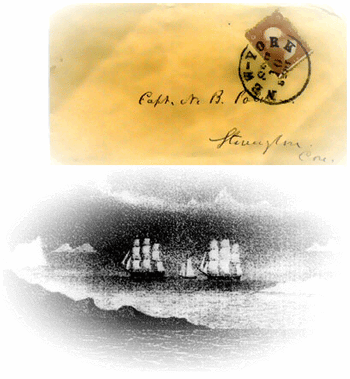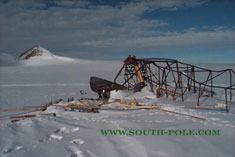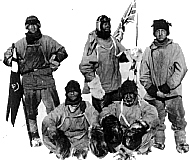Arctic & Antarctic History on the Net (original) (raw)

Welcome to the home page of South-Pole.com. This site is dedicated to the heroic explorers of our polar regions and the surrounding islands. The tales of these brave souls were often related in expedition mail sent home to anxious loved ones and beneficiaries. As you browse through this site, you will witness an extensive mix of reference material that will be useful to philatelists and students of polar history alike. For example, to the left you will notice a letter addressed to Capt. Nathaniel B. Palmer (1799-1877), who went to sea at the age of 14. At the age of 20, he played a major role as captain and part-owner of the HERO on the Fanning-Pendleton Sealing Expedition. The following season, as commander of the JAMES MONROE, he and British sealer George Powell together discovered the South Orkney Islands.
While the history of Arctic adventure essentially begins with the nineteenth century quest for the Northwest Passage and North Pole, the early explorers to Antarctic seas made sojourns solely for commercial reasons, some of which, incidentally, made new discoveries. The majority of these voyages, along with the highest development of the whaling and sealing industry, came in the nineteenth century when operations took place in every ocean of the world. Many of the peri-Antarctic islands were discovered by sealers or whalers and the first landings on half of them were made by men engaged in the whale and penguin oil industry. A particular problem with many sealing voyages was the secrecy with which the industry was conducted; should a captain and crew discover a new sealing area, they normally concealed its location in the hope of having no competition when exploiting it on subsequent voyages. The early sealing industry declined as the population of Fur seals and Elephant seals were reduced to such an extent that the industry became virtually unprofitable.

| | The second major exploitation of Antarctic resources began in 1904 with the establishment of the modern whaling industry. At various times shore stations operated in the Falkland Islands, South Shetland Islands, South Orkney Islands, South Georgia, Iles Kerguélen, Macquarie Island and Campbell Island; "floating" factories were moored at these and several other locations. In July 1895, the Sixth International Geographical Congress was held in London for the primary purpose of rekindling interest in Antarctic exploration. This is generally referred to as the beginning of the HEROIC ERA of Antarctic exploration, dating from Adrien de Gerlache's BELGIAN ANTARCTIC EXPEDITION aboard BELGICA in 1897, extending to Richard Byrd's FIRST BYRD ANTARCTIC EXPEDITION in 1928. | | ----------------------------------------------------------------------------------------------------------------------------------------------------------------------------------------------------------------------------------------------------------------------------------------------------------------------------------------------------------------------------------------------------------------------------------------------------------------------------------------------------------------------------------------------------------------------------------------------------------------------------------------------------------------------------------------------------------------------------------------------------------------------------------------------------------------------------------------------------------------- |
 Wreck of the Fokker / First Byrd Antarctic Expedition March 15, 1929 Wreck of the Fokker / First Byrd Antarctic Expedition March 15, 1929 |
Following World War II, a war-weary and economically challenged world began seriously contemplating new problems . . . problems escalating in a climate of uneasy peace referred to as the Cold War. In November 1946 the U.S. Navy launched the largest Antarctic expedition ever organized. Code-named OPERATION HIGHJUMP , Rear Admiral Richard E. Byrd led 4700 men, aboard thirteen ships with twenty-three aircraft, on the US NAVY ANTARCTIC DEVELOPMENTS PROJECT 1946-47.. As Byrd said, "The object lesson of all this is obvious. The shortest distance between the new and old worlds is across the Arctic Ocean and the north polar regions. It is freely predicted that here will be one of the great battle areas of future wars". The first American casualties in Antarctica came in a tragic PBM Mariner "flying boat" crash on Thurston Island, southwest of Peter I Island, during this expedition. Be sure to read Antarctic Mayday, the story as told by a crash survivor, and Tragedy on the Ice, the story of Fred Williams who wasn't so lucky. Both are compelling stories of courage and faith, personal accounts you will find only on this site. The entire story of the expedition is presented here together with an extensive display of postal history information and additional personal stories. |
|---|
Postal history examples prior to the Byrd expeditions are exceedingly rare and are coveted by polar philatelists worldwide. Souvenir pieces were occasionally created during the early years of exploration, yet prices even for these items remain firmly at triple, and often quadruple-digit levels. Beginning with the BYRD FIRST ANTARCTIC EXPEDITION in 1928, a proliferation of souvenir mail was created to help offset the tremendous expenses that came with exploration of this sort. But, one should not take it for granted that all pieces from this point forward are easily attainable . . . quite the contrary!
| | There are a number of items, from as recently as OPERATION DEEPFREEZE, that command very high prices. However, it is generally acknowledged that postal history, beginning with the BYRD SECOND ANTARCTIC EXPEDITION, becomes affordable to most of us. Illustrated here is a postal history example from the HEROIC ERA, from a set of four Links of the Empire postcards that were released in support of Robert Scott's BRITISH NATIONAL ANTARCTIC EXPEDITION. This commemorative postcard was hand-canceled in London on July 31, 1901. . . the day DISCOVERY left the London Docks and slowly wound her way down the Thames, launching the start of Scott's historic expedition. Postcard publishers E. Wrench, of London, advertised the four cards for a subscription price of two shillings (10p), with each card receiving a postmark from a suitable port of call. | | ------------------------------------------------------------------------------------------------------------------------------------------------------------------------------------------------------------------------------------------------------------------------------------------------------------------------------------------------------------------------------------------------------------------------------------------------------------------------------------------------------------------------------------------------------------------------------------------------------------------------------------------------------------------------------------------------------------------------------------------------------------------------------------------------------------------------------------------------------------------------------------------------------------------------------------------------- |

This site also includes a superb selection of postal history, along with related stories, of our polar cousin to the north, the Arctic. You may be surprised to learn that many of our famous Antarctic explorers were first exposed to polar exploration in the Arctic. In Antarctica, the Ross Sea, McMurdo Sound and Mt. Erebus are all famous landmarks named by their discoverer, Sir James Clark Ross. However, Ross developed his thirst for polar exploration in the Arctic. His first taste of polar exploration came in 1818 aboard ISABELLA when, as a young midshipman, he joined his uncle, Sir John Ross, on an expedition to locate the Northwest Passage. A crowning achievement came in the spring of 1831 when he and his uncle, aboard VICTORY, discovered the North Magnetic Pole. Similar Arctic adventures can be told about Roald Amundsen, Sir Hubert Wilkins and Richard E. Byrd, to name a few.
I wish to personally thank all contributing members of the American Society of Polar Philatelists for their generous contributions and research provided to this website. You can visit them at www.polarphilatelists.org. The postal history displayed on this site has been compiled from collections that have won multiple awards at philatelic exhibitions around the world. You will be amazed at the number and rarity of pieces displayed ... over 500 in total. Whether a philatelist or simply a student of history, your appetite for polar exploration, as authenticated by its mail, will truly be fulfilled. Be sure to come back often as this is a work in progress!

©1996-2024 South-Pole.com